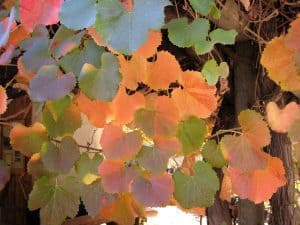Cool nights, pleasant days, and beautiful gardens in the forecast.

History/review
The fall equinox (equi=same, nox=night) is a few days behind us, and that means that the earth’s axis just tilted in our favor. The pattern for California’s wet season is clearly in view now and this means that all our activities, including new plantings, will soon be blessed by rain. Remember all those tasks we conveniently postponed during the summer months? Now we can do them, so go outside and play in the garden. Keep reading…
Watering
Watch the weather forecast. If we get word of an approaching storm, delay watering and let nature do it. In that same light, if the forecast calls for a dry spell with Santa Ana winds, you will probably need to do a thorough watering, saturating the soil as if 1.5 – 2” of rainfall had fallen. See Watering Guide for all the details, or simply look at the installments for July
and August. You will get a good idea of what it takes to properly water native plants.
If our rains tarry until November or later (possible) or hot winds come in October (likely), you will need to conduct one of your deep soaks (1.5 – 2”) this month. It will (probably) be your last of only five or six this year. But stay tuned. In years past we have seen some very dry autumns and this winter we have absolutely no guarantee for decent rains.
Related to Watering
Regardless of the weather, here is something you should do if you have not already done it: make contour grading, swales, basins, berms, mounds and valleys large and small. By creating varied microtopography, you will slow down the surface flow of water and allow rain and irrigation water to penetrate effectively. Just dig little rills and rivulets, basins and berms a few inches deep, snaking through your garden. You can incorporate some good mulch at the same time and enliven the top four inches of soil… perfect timing for those long awaited rains.
Pruning
At this time, it is advisable to remove all unsightly summer seed heads, e.g.; buckwheat, sage, sunflower, grasses, goldenrod, etc. Scatter the seed as you see fit, and break up the stems to make your own mulch if you like. Most natives do not need heading back or shaping at this time, as that pruning usually takes place in late spring. However, a few woody shrubs e.g.; lemonade berry, coffeeberry, cherry, sugarbush, etc. might benefit from some shaping by trimming off the branch ends. Avoid making artificial shapes unless you want a Mickey Mouse or a Santa’s reindeer topiary, and if you do, then have at it… it’s your garden. Major thinning and pruning that would open up the plant’s branching habit can wait until mid winter, so we’ll discuss that topic then.
Weeding
If you have been reading “This Month in the Natural Garden,” and following along, your garden is weed free right now. Summer weeds have been carted off, and winter weeds are not yet present. Congratulations. If not, go out and get whatever weeds you see.
Mulching/Top dress
If your garden is not yet making its own “mulch,” (leaf drop, low branches that shade the root zone, and accumulated organic matter) and you want that “look”, you can apply 2-3” of an organic top dressing consisting of clean chipped bark. Mineral top dressing (gravel, decomposed granite, pebbles, etc.) should never need refreshing, but if you want to add them for the first time, use them in conjunction with your microtopography to create a natural look. If you import any top dressing, know this… you should leave some areas of bare earth, as native bee species need plain dirt for making their nests. They do not live in colonies. They are solitary, meaning that a single bee will dig a little hole to lay her eggs in. But only if you leave her some bare dirt.

Feeding
Since you are out scratching up all that dirt with the microtopography and top dress renewal, you can also scatter a little dry organic fertilizer, and incorporate it into the top couple inches. Follow label instructions for application rates, or use about half, as native plants are super efficient at finding nutrients.
Troubleshooting – Varmints, Pests and Diseases
Bunnies, deer and other plant munchers will still come around if you are lucky enough to live where they live. Controlling their eating habits can be difficult, but if you have them, you probably already know what works best for you. If you need help, write me at gardenhelp@californianativeplants.com. Most injurious insect pests are not very active in fall, but you always have to be on the lookout. If you see Argentine ants on your plants, it is very likely you have scale, mealybug, or aphid. The ants feed on the sweet excretion (honeydew) as the aphid sucks on your plant. You need to get rid of both. Use a growth regulator for ants and simply blast the other bad guys off with a hose, or use organic soaps/oil sprays. (See September installment).
Annual Wildflowers
Technically you could scatter wildflower seeds now and wait for winter rains to get them started. However, with the probability for a couple heat waves with Santa Ana winds, you might want to wait until after we get our first good rain. After the soil is uniformly soaked you can scatter the seed anytime, or a few times, November through February.
Adding New Plants
Yes, yes, and yes. October is the best month for planting natives. Fall will bring rain and colder temps, and come spring, your plants will be on their way to full establishment, so that next summer they will be easy to care for. October is for planting. Be sure to watch this instructional video, if you haven’t done so already you can watch here.
Engage
For many, fall is the best time of year. The sunlight is just right, we get some incredibly clear days, cool nights, a few warm spells, and hints of rain. Watching clouds is good fun. Evenings in the garden are great, when the birds start to bed down. Early mornings are sometimes extraordinary with sunrises that can’t be beat. Watching the natural garden spring back to life after toughing it out through summer gives one a true sense of renewal. And we all need that every little once in awhile.
From the Garden,
Mike Evans
Questions? Help is just one call or one email away. Call (949) 728-0695 or email (with pictures if you like) our brand new help email: gardenhelp@californianativeplants.com.